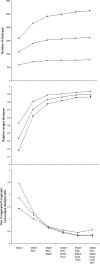Selection of enzymes for terminal restriction fragment length polymorphism analysis of fungal internally transcribed spacer sequences
- PMID: 19465521
- PMCID: PMC2708443
- DOI: 10.1128/AEM.00568-09
Selection of enzymes for terminal restriction fragment length polymorphism analysis of fungal internally transcribed spacer sequences
Abstract
Terminal restriction fragment length polymorphism (TRFLP) profiling of the internally transcribed spacer (ITS) ribosomal DNA of unknown fungal communities is currently unsupported by a broad-range enzyme-choosing rationale. An in silico study of terminal fragment size distribution was therefore performed following virtual digestion (by use of a set of commercially available 135 type IIP restriction endonucleases) of all published fungal ITS sequences putatively annealing to primers ITS1 and ITS4. Different diversity measurements were used to rank primer-enzyme pairs according to the richness and evenness that they showed. Top-performing pairs were hierarchically clustered to test for data dependency. The enzyme set composed of MaeII, BfaI, and BstNI returned much better results than randomly chosen enzyme sets in computer simulations and is therefore recommended for in vitro TRFLP profiling of fungal ITSs.
Figures


References
-
- Abdo, Z., U. M. E. Schüette, S. J. Bent, C. J. Williams, L. J. Forney, and P. Joyce. 2006. Statistical methods for characterizing diversity of microbial communities by analysis of terminal restriction fragment length polymorphisms of 16S rRNA genes. Environ. Microbiol. 8:929-938. - PubMed
-
- Avis, P. G., I. A. Dickie, and G. M. Mueller. 2006. A ‘dirty’ business: testing the limitations of terminal restriction length polymorphism (TRFLP) analysis of soil fungi. Mol. Ecol. 15:873-882. - PubMed
-
- Avis, P. G., G. M. Mueller, and J. Lussenhop. 2008. Ectomycorrhizal fungal communities in two North American oak forests respond to nitrogen addition. New Phytol. 179:472-483. - PubMed
-
- Buchan, A., S. Y. Newell, J. I. L. Moreta, and M. A. Moran. 2002. Analysis of internal transcribed spacer (ITS) regions of rRNA genes in fungal communities in a Southeastern U.S. salt marsh. Microb. Ecol. 43:329-340. - PubMed
Publication types
MeSH terms
Substances
LinkOut - more resources
Full Text Sources
Medical

